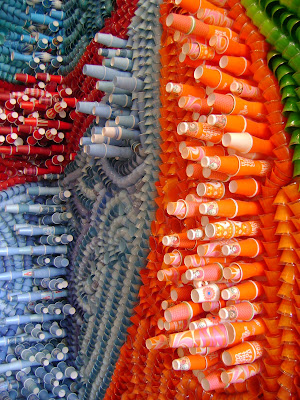

My last museum experience was The Aldrich Contemporary Art Museum. Again, I wasn’t expecting much. After all, it was in Ridgefield! The museum was set back from the street, and we actually passed the museum twice before we realized where it was. Immediately, I noticed the architecture, and could appreciate the clean lines of the building. The front lawn highlighted sculptures that were made of what looked like rusted iron. There were no plaques to note the artist or medium used; however, the pieces certainly made the viewer take notice. The first lawn sculpture was of a car standing on its back wheels. The second was of an iron spider, and the third was a bike rack that displayed “I’m watching you.” Little did I know the main exhibit was entitled “Bike Rides?” To my surprise, there was no photography allowed in the museum. The staff assured me that I could find all their pieces online if I needed to them.
The museum is a two story building that is one of the only museums in Connecticut that does not have a permanent exhibit. All the pieces in the museum are on loan from private donors. That fact actually increased my intrigue. The main hall displayed a wall size mural that had black and white images and words describing the current state of our globe due to climate change. There were all sorts of facts about riding bikes, and the benefits that it would have on the climate and global warming.
The first room housed bikes that were actually ridden by bike groups. There was a trio of “low riders”, which were no more than 1 yard in height, from a group out of New York. The bikes were elaborate, and had tons of decorative metal designs and axils. There was another bike displayed that had hundreds of signs, flags, stickers, horns, and even an actual radio with speakers. It was a billboard for Puerto Rico, as everything on that bike had something to do with Puerto Rico. The front sign said, “Yo soy Boricua. Mi amor es Puerto Rico”, which means, I am Puerto Rican. My love is Puerto Rico. I don’t think anyone could argue who much the owner loved Puerto Rico after seeing the decoration on that bike!
There were other bikes displayed throughout the museum, as pieces of art, and as bikes that people can actually ride. Lance Armstrong’s bikes were displayed, and the docent directed us to a bike that was for sale for $8000! Amazing, I didn’t know that bikes were even sold for half that much! Upstairs, there was a less expense bike, and was owned by a Chinese man. He had hung inflatable balloons from the bike, and would bike around villages in China and give them to children. In addition, there were also sculptural pieces by Edward Tufte that were exhibited in the gallery, as well as, on the back lawn.
The one artist that captured my attention immediately with her taxidermy work was Kate Clark. Kate is a Michigan native who combines taxidermy with sculpting. Her work is as realistic as Hanson’s work, which had me in awe at the Yale Art Gallery. Kate uses real animal heads and bodies and sculpts human faces on them. The eyes are rubber and the faces are made out of leather, clay, and foam, and are emphasized with small metal pins. Kate’s goal is to show how similar animal faces and facial expressions are to humans. The docent quoted an interesting fact about children with autism when discussing Clark’s pieces. She noted that most children with autism do not look at other people in the eyes; however, they do with animals, possibly because of an innate connectedness that humans unknowingly have with animals.
The initial piece that grabbed my attention was of three antelope whose gazes were fixed on the entry way. The bright blue eyes of the center antelope shocked and scared me, all while intriguing me. As I looked closer, I could see that there were pieces of the animal’s skin that were positioned like patchwork and combined with the other mediums. Fascinating! Clark’s other pieces from that series was a head of a zebra and a baby bison. The baby bison’s face was so cute, and reminded me of my daughter’s face when she’d look up at me as to say, “Hey, don’t forget about me.”
I certainly will not forget about this exhibit or this museum. I am excited to see what new pieces will be added in January when the exhibits change. I look forward to visiting Ridgefield and the Aldrich Museum again.
















































